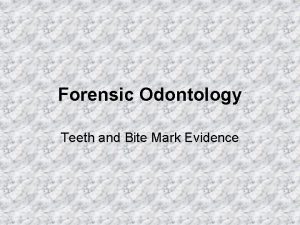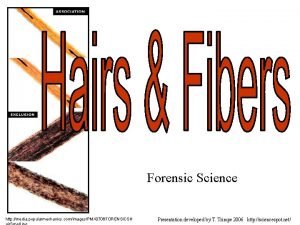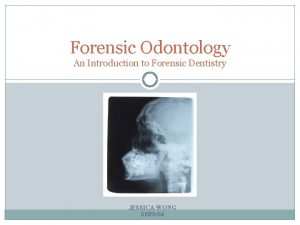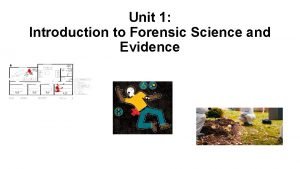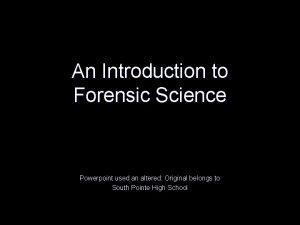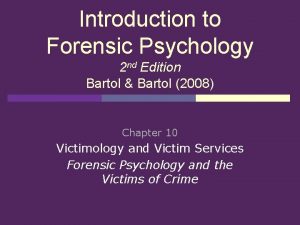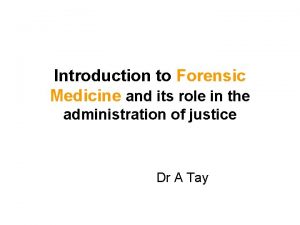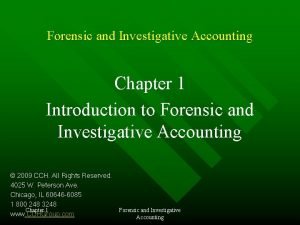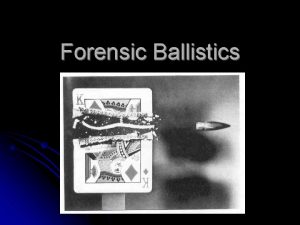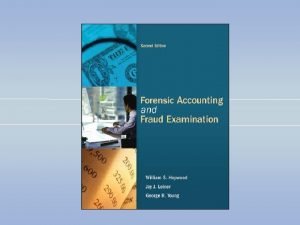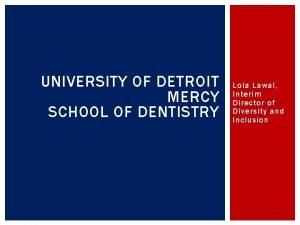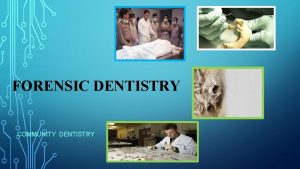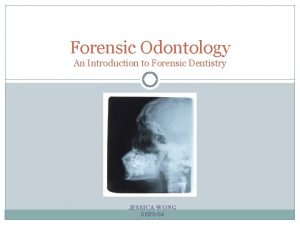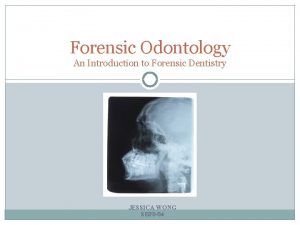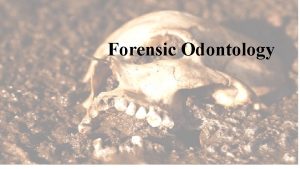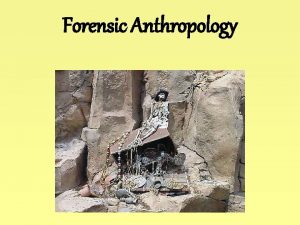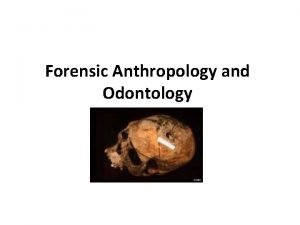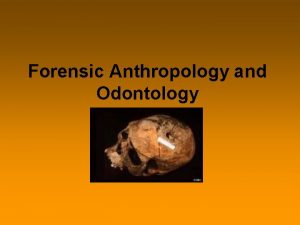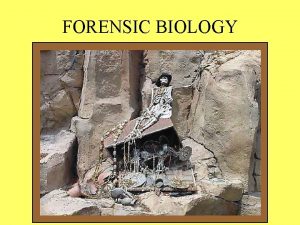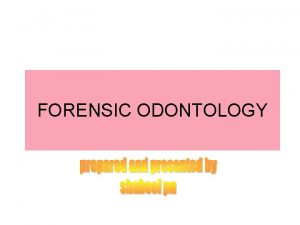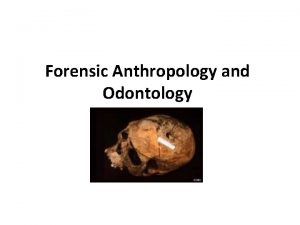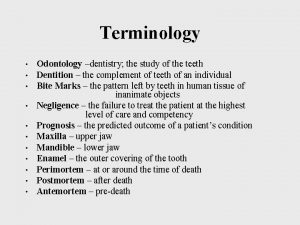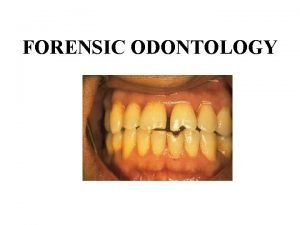Forensic Odontology An Introduction to Forensic Dentistry JESSICA






















- Slides: 22

Forensic Odontology An Introduction to Forensic Dentistry JESSICA WONG SBF 6 -04

Forensic Odontology FORENSIC ODONTOLOGY IS THE APPLICATION OF DENTISTRY IN LEGAL PROCEEDINGS DERIVING FROM ANY EVIDENCE THAT PERTAINS TO TEETH.

Why Teeth? Every human body ages in a similar manner, the teeth also follow a semi-standardized pattern. These quantitative measurements help establish relative age of person. Each human has an individual set of teeth which can be traced back to established dental records to find missing individuals. Teeth is made of enamel (hardest tissue of the body) so it can withstand trauma (decomposition, heat degradation, water immersion, and desiccation) better than other tissues in body. Teeth are a source of DNA: dental pulp or a crushed tooth can provide nuclear or mitochondrial DNA that to help identify a person.

Who practices Forensic Odontology and what do they do? Forensic Odontologists Must have DDS degree Should have specialized training in the field through lectures (not required) Forensic dentists help: Identify human remains (individual and mass) Analyze bite marks Top: Forensic Odontologist analyzing animal teeth for comparison. Side: Seal for American Board of Forensic Odontology. Bite marks are compared to known teeth molds to find origin of bite injuries Estimate age of the victim and perpetrator Trace dental malpractice

History of Forensic Odontology 66 AD – First body identified using teeth Lollia Paulina Revolutionary War Paul Revere was the first forensic dentist in the United States because he identified fallen revolutionary soldiers. 1849 – Mass deaths at Vienna Opera House Fire Dental evidence is first admitted into court system in US

Organizations of Forensic Odontology Bureau of Legal Dentistry (BOLD) American Board of Forensic Odontology (ABFO) International Organization for Forensic Odonto-Stomatology (IOFOS)

Teeth HARDEST PART OF BODY ATTACHED TO JAWS. IT SERVES TO HELP DIGEST FOOD, ACT AS A DEFENSE MECHANISM, ETC. TEETH ARE MADE OF A CROWN WITH ENAMEL SURROUNDING A PULP.

Teeth Basics Approximately 32 teeth in adult mouth Four types of teeth: Molars Premolars Canine Incisors Teeth differ in: Size Shape Root type Types of teeth. Left to right: Incisor, Canine, Premolar, molar.

Teeth through the years Childhood Primary teeth sprout from milk buds and are temporary. Once they fall out, permanent teeth as seen on the other side appear. Adulthood Permanent adult teeth come in when primary teeth fall out; they are permanent because they establish roots inside the gums. Third molar come in around the mid teenage years.

Standard Teeth Development for Age Determination

Individual Characteristics Size of tooth Shape of root Placement of tooth Quantity of teeth Combinations of dental work done: Crowns Extractions Bridge Fillings Root canals Various dental work

Analyzing Teeth The Universal System 1. Teeth are given a specific number. (Primary teeth are given specific capital letter) 2. Any dental work done on surface is noted 3. Sheets kept on dental file forever. When person is missing, files are transferred to the missing person’s office

Analyzing Teeth Maxillary – upper Anterior: 6 -11 Posterior: 1 -5, 12 -16 Mandibular – lower Anterior: 22 -27 Posterior: 17 -21, 28 -32

Various Teeth Found

Bite Marks IMPRESSIONS FROM TEETH FOUND ON SKIN OR ITEMS LEFT AT A SCENE. USUALLY OUTLINE TEETH PLACEMENT.

Where are bite marks found? Impressions left on food, skin or other items left at a scene. Porous surfaces that absorb the impact enough to make an impression Impressions vary Depending on the pressure applied, the impression will show accordingly. The more pressure there is, the more detail to the bite.

Analyzing bite marks 1) Bite marks are photographed with a scale Bite marks on skin are taken over repeated intervals 2) Casts of impression are taken 3) Impression traced onto transparencies 4) Casts of suspects teeth are taken 5) Comparison between suspect cast and bite mark

Various Bite Marks

State of Florida v. Ted Bundy, was an American serial killer who murdered numerous young women between 1974 and 1978. He confessed to 30 murders, however the total amount of victims remains unknown. He would bludgeon his victims, then strangle them to death. He engaged in rape and necrophilia. Evidence, various pictures from trial

Computer Odontology Automatic dental code matching Bites are run through the computer to find a match Odonto. Search Compare a data base of missing peoples, felons, government workers Automatic dental identification system A few minutes will produce a list of people who have the same dental code number 3 D Bite mark analysis 3 D scans of dental casts are used to generate overlays using various pressure and deviation. The overlays are compared with the photograph of the bite marks.

• http: //www. forensicdentistryonline. org/Forensic_pages_1/ident_guidelines. htm • http: //www. dentalforensics. com/bite%20 mark%20 injury. htm • http: //www. cse. msu. edu/~cse 891/Sect 601/Case. Study/Forensic. Odontology. pdf • http: //www. all-about-forensic-science. com/forensic-odontology. html • http: //www. abfo. org/ • http: //www. theiai. org/disciplines/odontology/index. php • www. forensicsciencesfoundation. org • http: //en. wikipedia. org/wiki/Ted_Bundy • http: //health. allrefer. com/health/dental-x-rays-development-of-permanent-teeth. html References

• SLIDE 1 : http: //www. angelliftdental. com/sitebuildercontent/sitebuilderpictures/. pond/3652330800 x 720. jpg. w 300 h 333. jpg • SLIDE 2: www. forensicsciencesfoundation. org • SLIDE 3: www. forensicsciencesfoundation. org • SLIDE 4: http: //img 55. imageshack. us/img 55/4073/zdg 9. jpg • SLIDE 5: http: //www. dentalforensics. com/bite%20 mark%20 injury. htm • SLIDE 6: http: //www. cse. msu. edu/~cse 891/Sect 601/Case. Study/Forensic. Odontology. pdf • SLIDE 7: http: //www. cse. msu. edu/~cse 891/Sect 601/Case. Study/Forensic. Odontology. pdf • SLIDE 8: http: //www. nlm. nih. gov/medlineplus/ency/imagepages/1138. htm • SLIDE 9: http: //www. diyfather. com/files/baby_teeth. jpg http: //medicalimages. allrefer. com/large/development-of-permanent-teeth. jpg • SLIDE 10: http: //a. abcnews. com/images/The. Law/nm_bite_080514_mn. jpg • SLIDE 11: http: //www. dentalforensics. com/bite%20 mark%20 injury. htm • SLIDE 12: http: //www. cse. msu. edu/~cse 891/Sect 601/Case. Study/Forensic. Odontology. pdf • SLIDE 13: http: //www. sciencemag. org/content/vol 309/issue 5736/images/small/309_892_F 2. gif • SLIDE 14: http: //thetoothfairy. net/images/awm. jpg http: //forensicfact. files. wordpress. com/2008/05/image 015. jpg http: //www. dentalforensics. com/bite%20 mark%20 injury. htm • SLIDE 15 -17: http: //www. cse. msu. edu/~cse 891/Sect 601/Case. Study/Forensic. Odontology. pdf • SLIDE 18: http: //phampl. com/biteck. jpg http: //www. dentalforensics. com/bite%20 mark%20 injury. htm http: //eforensicmed. googlepages. com/800 px-Cyst_-_wisdom_tooth. jpg/800 px-Cyst_-_wisdom_toothfull. jpg • SLIDE 19 -20: http: //www. cse. msu. edu/~cse 891/Sect 601/Case. Study/Forensic. Odontology. pdf References for pictures
 What is forensic odontology definition
What is forensic odontology definition Tore solheim
Tore solheim Surfaces of teeth
Surfaces of teeth Forensic odontology definition
Forensic odontology definition Forensic odontology would not be useful for _____.
Forensic odontology would not be useful for _____. Forensic odontology
Forensic odontology Examples of transient evidence
Examples of transient evidence Define odontology
Define odontology Forensic anthropologist vs forensic pathologist
Forensic anthropologist vs forensic pathologist Forensic psychiatry vs forensic psychology
Forensic psychiatry vs forensic psychology Introduction to jessica
Introduction to jessica History of forensic science ppt
History of forensic science ppt Introduction to forensic psychology bartol pdf
Introduction to forensic psychology bartol pdf Locard's exchange principle
Locard's exchange principle Forensic science an introduction
Forensic science an introduction Chapter 1 intro to forensic science
Chapter 1 intro to forensic science Introduction to forensic medicine
Introduction to forensic medicine Introduction to forensic accounting
Introduction to forensic accounting What is ballistics?
What is ballistics? Introduction to forensic accounting
Introduction to forensic accounting Detroit mercy summer enrichment program
Detroit mercy summer enrichment program Flush terminal plane
Flush terminal plane Theories of mineralisation
Theories of mineralisation


